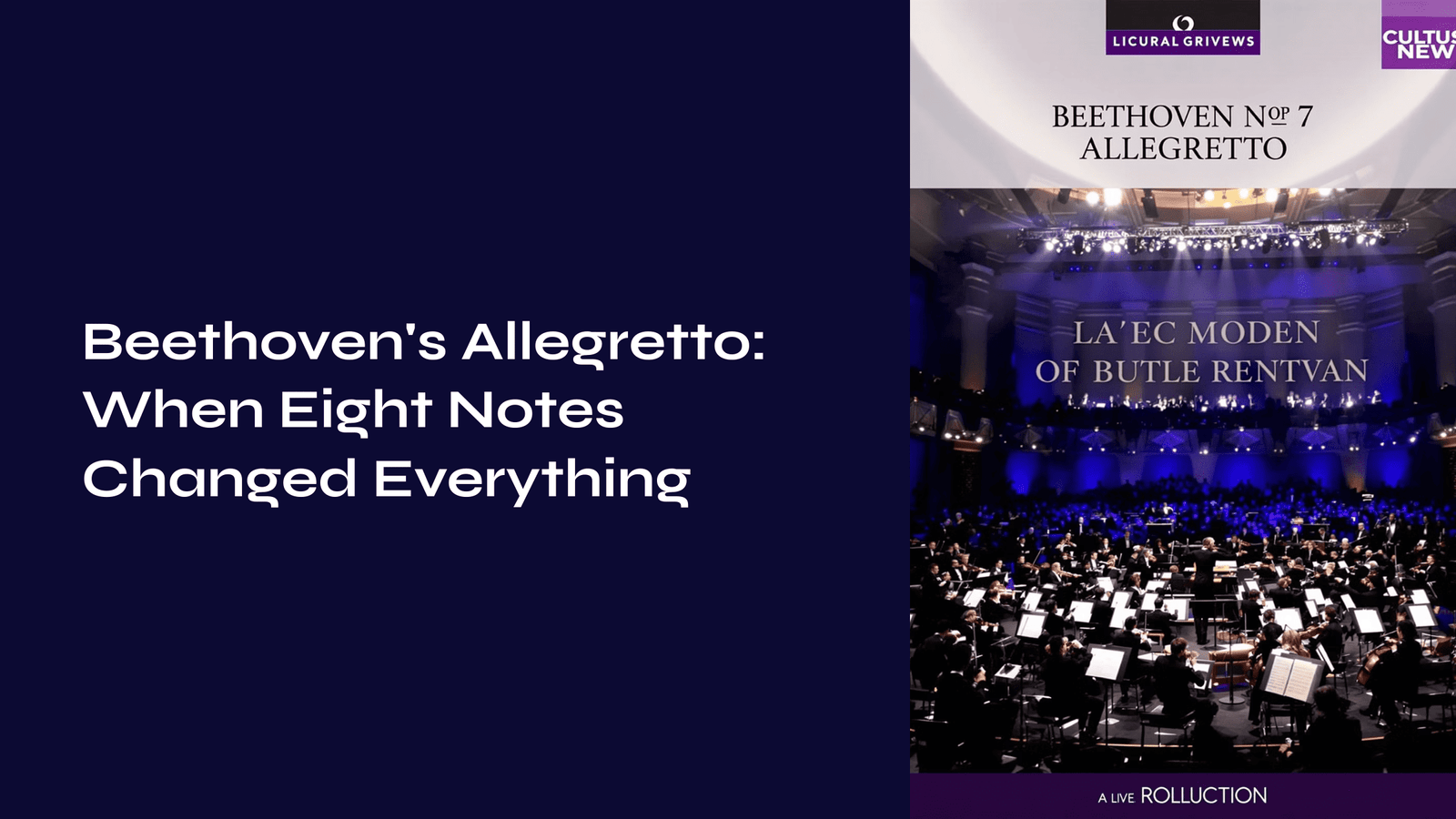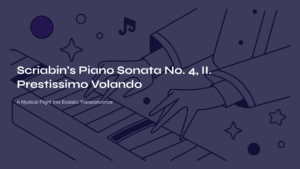Table of Contents

The Sound That Stops Time
There’s something almost supernatural about the way certain pieces of music can halt everything around you. You’re going about your day, perhaps stuck in traffic or waiting for coffee, when suddenly those eight haunting notes emerge from nowhere—da da da-da, da da—and the world seems to pause. That’s the power of Beethoven’s Allegretto from his Symphony No. 7, a movement so compelling that audiences demanded an encore at its very first performance. It’s a piece that transforms eight simple notes into one of music’s most profound statements about human resilience.

A Symphony Born from Struggle
Ludwig van Beethoven composed his Seventh Symphony between 1811 and 1812, during one of the most challenging periods of his life. His hearing loss was advancing relentlessly, yet paradoxically, this symphony radiates with an almost defiant vitality. The work premiered in 1813 at a charity concert for soldiers wounded in the Napoleonic Wars—a setting that perhaps made its emotional depth even more poignant.
What makes this historical context so fascinating is how Beethoven channeled his personal struggles into something universally moving. While the symphony as a whole pulses with what Richard Wagner called “the apotheosis of the dance,” the second movement—our beloved Allegretto—stands apart like a moment of profound reflection amidst celebration.
The premiere was nothing short of extraordinary. Viennese audiences were so moved by the Allegretto that they demanded it be played again immediately—a rare honor for any symphonic movement. Contemporary accounts describe listeners moved to tears, a testament to music’s power to speak directly to the human soul.

The Architecture of Emotion
Let’s dive into what makes this movement so special. The Allegretto is built on what musicians call an ostinato—a persistently repeated musical phrase. In this case, it’s those eight notes in A minor that create an almost hypnotic foundation, like a heartbeat that never stops.
The Opening: Violas and cellos introduce that unforgettable rhythm—quarter note, two eighths, two quarters—creating what feels like a funeral march, yet somehow more complex than simple mourning. There’s dignity in this rhythm, a sense of moving forward despite weight.
The Melody Enters: When the violins join with their haunting melody above the continuing ostinato, magic happens. It’s as if hope and despair are having a conversation, neither overwhelming the other, both necessary for the complete emotional picture.
The Bright Interlude: Just when the minor key threatens to become overwhelming, Beethoven shifts to A major. Suddenly, clarinets and bassoons weave a serene, almost hymn-like theme that feels like sunlight breaking through storm clouds. The French composer Hector Berlioz beautifully described this section as “patience smiling at suffering.”
The Climactic Return: The movement builds to an incredible fugato—where different sections of the orchestra enter with the main theme at different times, creating a web of sound that grows increasingly intense until it reaches a thunderous climax, only to dissolve back into the fragile beauty of the opening.

When Folk Dance Meets High Art
Here’s something fascinating that many listeners don’t realize: this profoundly moving piece has its roots in folk dance. During the time Beethoven was composing this symphony, he was also arranging Irish, Scottish, and Welsh folk songs, and those rhythmic patterns seeped into his symphonic writing.
The ostinato’s pattern—that long-short-short rhythm—echoes traditional Austrian dances like the ländler. Beethoven took something as communal and joyful as folk dance and transformed it into a meditation on mortality and hope. It’s a perfect example of how great composers can take the familiar and make it transcendent.
This connection to dance music explains why the movement feels so physically compelling. Even in its somber A minor passages, there’s an underlying pulse that seems to move through your body, connecting you to something both ancient and eternal.

My Journey with the Allegretto
I’ll admit, my first encounter with this movement was almost accidental. I was exploring Beethoven’s symphonies systematically, expecting the Seventh to be energetic throughout—after all, it’s known as the “dance symphony.” When the Allegretto began, I was completely unprepared for its emotional intensity.
What struck me most was how the music seemed to contain contradictions that somehow made perfect sense. It’s mournful yet hopeful, simple yet complex, ancient yet timeless. The ostinato becomes almost meditative—after hearing it repeated ninety times throughout the movement, it feels less like repetition and more like a mantra, each return revealing new layers of meaning.
There’s something deeply human about this music. It doesn’t try to solve life’s contradictions or offer easy comfort. Instead, it acknowledges that we carry both sorrow and joy, that resilience isn’t about eliminating struggle but about finding beauty within it.

How to Listen Like a Detective
Want to get the most out of this extraordinary movement? Here are some listening strategies that have enhanced my own experience:
Focus on the Bass Line: Those violas and cellos carrying the ostinato are your anchor. Notice how Beethoven never lets you forget that rhythmic foundation, even when the upper voices are spinning the most elaborate melodies.
Follow the Conversations: Listen for how different sections of the orchestra seem to respond to each other. The woodwinds often seem to offer comfort when the strings express anguish.
Pay Attention to Dynamics: Beethoven’s range from whispered pianissimos to thunderous fortissimos isn’t just for effect—each dynamic level reveals different aspects of the emotional landscape.
Count the Variations: Try to notice how many different ways Beethoven presents that basic eight-note pattern. It’s like watching a master painter create dozens of different moods using the same basic color palette.
Listen for the Silences: Some of the most powerful moments come in the spaces between notes, where the music seems to breathe and reflect.

A Legacy That Transcends the Concert Hall
The Allegretto’s influence extends far beyond classical music. Filmmakers have used it to underscore everything from romantic longing to existential crisis—most famously in Luchino Visconti’s “Death in Venice.” Jazz musicians have reimagined its harmonies, and it’s been arranged for everything from solo piano to full percussion ensembles.
Perhaps most meaningfully, it has served as a soundtrack to historical moments. When the Berlin Wall fell in 1989, conductor Daniel Barenboim led a performance that seemed to capture both the weight of history and the hope of liberation. This is music that speaks to something fundamental in the human experience.

The Paradox of Perfection
What makes Beethoven’s Allegretto truly remarkable is its paradoxical simplicity. On paper, it’s relatively straightforward—the individual parts aren’t technically demanding, and the structure is clear. Yet the cumulative effect is profound. Beethoven proves that constraints can fuel creativity rather than limit it. By committing to that eight-note ostinato, he created a framework that allowed for incredible emotional and musical development.
This movement reminds us that sometimes the most powerful art comes not from complexity for its own sake, but from taking something simple and exploring every facet of its possibility. In just eight to ten minutes, the Allegretto travels through sorrow, hope, and transcendence, leaving listeners with what Wagner called a sense of being “spiritually drunken” on its intoxicating blend of discipline and passion.
The next time you hear those eight notes, remember that you’re experiencing something that has moved listeners for over two centuries—a testament to music’s power to transform simple elements into profound statements about what it means to be human. In our often chaotic world, there’s something deeply comforting about music that acknowledges struggle while insisting on beauty, that finds universality in the most personal expressions of the human heart.

If You Loved This, Listen to This Next
If you were captivated by Beethoven’s ability to transform simple rhythmic patterns into profound emotional landscapes in this Allegretto, you might find yourself equally enchanted by Mahler’s Symphony No. 5: When Love Meets Musical Genius – where similar themes of struggle and transcendence unfold through sweeping orchestral colors and deeply personal musical storytelling that spans from funeral march to triumphant love song.
Both works reveal how great composers can channel life’s most intense experiences into music that speaks directly to the human condition, creating timeless pieces that continue to move and inspire listeners across generations.



